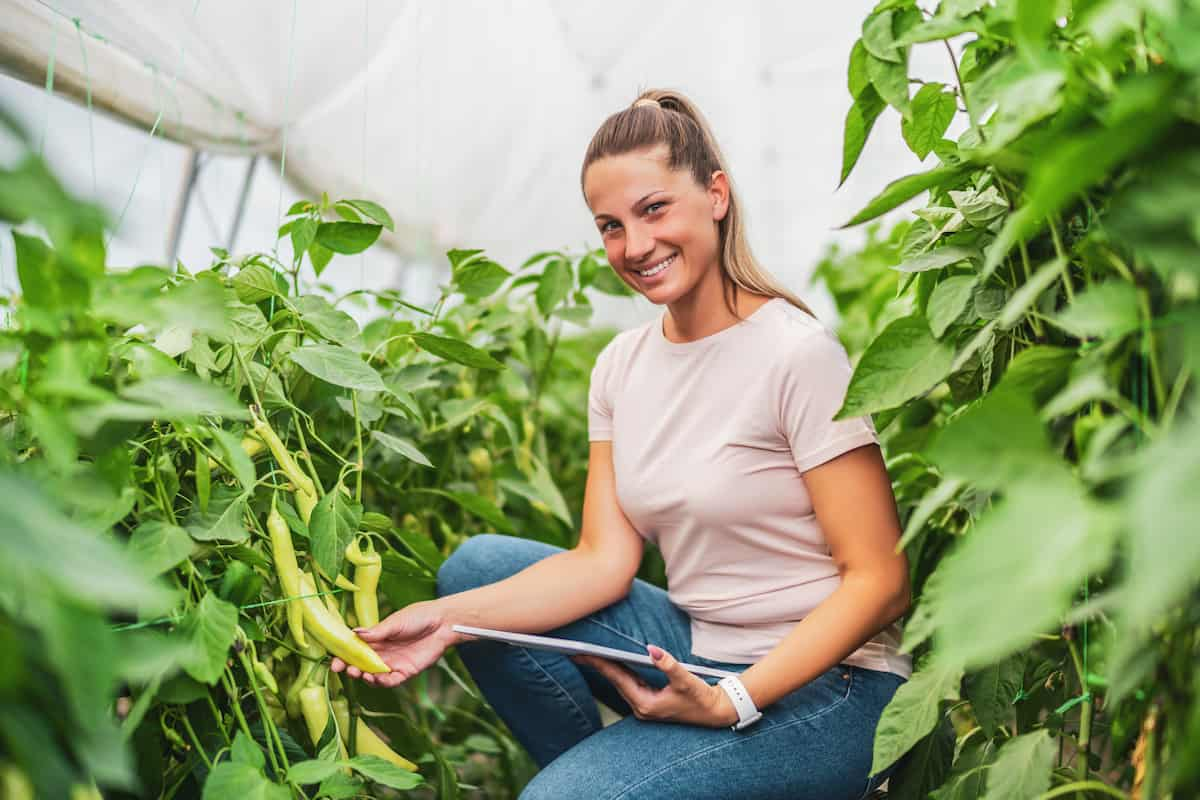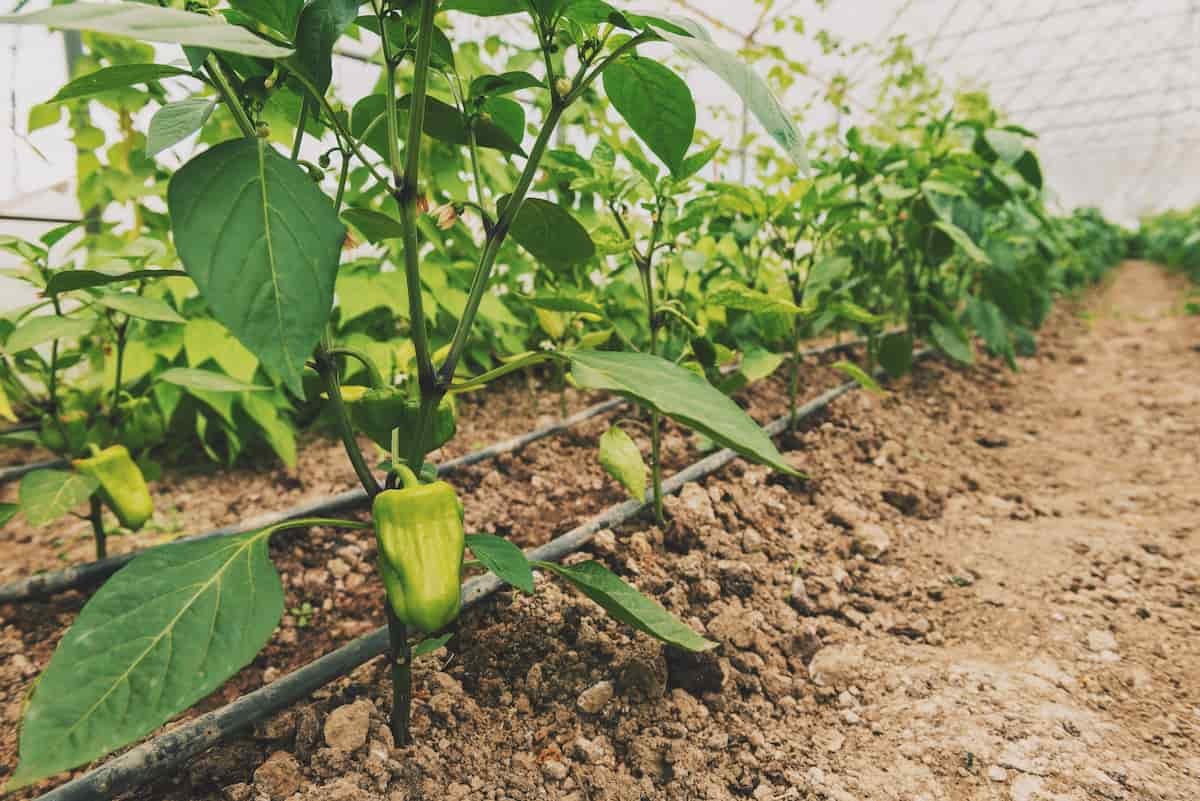The pepper crop is one of the most common crops consumed worldwide. This crop has wide varieties, including green, red, yellow, sweet, spicy, etc. It is not surprising that peppers can be grown in various environments. Many peppers are grown in greenhouses, even though some climates are perfect for outdoor cultivation.

As a greenhouse crop, pepper plants thrive in hot weather and prefer a long growing season. Planting peppers in a controlled greenhouse increases yields and quality, reduces pests and diseases, and extends the growing season. The high demand for peppers can be met year-round by cultivating pepper greenhouses.
How to Grow Peppers in Greenhouse
Best Soil Conditions for Growing in Greenhouse
Nutrient-rich soil with adequate calcium and phosphorus is best for pepper plants. Soil pH should be 6.0 to 7.0, and soil temperature should be at least 21°C. You should apply foliar feed roughly every 10 days when your pepper plants bloom. By doing this, you will ensure that your plants are healthy and that they produce large, juicy fruits. The proper dilution ratios are listed on your fertilizer package, but excessive fertilizing can cause damage.
Greenhouse Peppers Temperature Requirements
The temperature is one of the important factors to consider when growing greenhouse bell peppers. Providing the right temperature in your greenhouse is crucial for your peppers. The bell peppers in your greenhouse will not grow below 10°C to 12°C if the temperature exceeds 35°C.
| Development Stages | Minimum Temperature | Optimum Temperature | Maximum Temperature |
| Germination stage | 23°C | 26-28°C | 30°C |
| Vegetative growth stage | 21°C | 23-25°C | 28°C |
| Fruit set stage – nighttime | 15°C | 17-18°C | 20°C |
| Fruit set stage – daytime | 20°C | 23-25°C | 28°C |
Peppers grown in greenhouses are susceptible to cold damage below 6°C, frost damage below 1°C, and terminal damage below -2°C. Keep your greenhouse’s temperature above 6°C at all times. The relative humidity of 65-85% is ideal for greenhouse peppers. The growth of peppers is considered to be optimal within this range.
Planting Peppers in Greenhouse
Plant pepper seeds 1/2 inch deep in the containers and cover lightly with soilless media. When transplanting seeds to larger pots for growing, give each seed at least 1 square inch of space in a seed-starting tray. Two to three seeds should be planted in a 4-inch pot. Plastic wrap should be used to cover the containers. Pepper seeds do not require light to germinate but need warm soil between 18 and 35°C to break dormancy. The soil temperature should be raised to this level by placing heat mats under the containers.
Depending on the soil temperature, pepper seeds germinate in eight to three weeks. The seeds of hot peppers usually germinate slower than those of sweet peppers. The seedlings should be placed in an area of the greenhouse with bright light as soon as they emerge from the plastic containers. Water-soluble fertilizers mixed at half strength should be applied once or twice a week once the seedlings have their first true leaves. During this time, thin seedlings in 4-inch pots to one plant per pot or transplanted into larger containers or cell packs spaced one inch apart.
Transplanting Peppers in the Greenhouse
- Transplant the peppers into the greenhouse bell pepper bed. Use ground cover fabric to control weeds.
- The distance between them should be 18 to 24 inches.
- Maintain soil temperature and pH, and ensure all soil requirements are met.
- The soil should be well drained.
- A sufficient amount of moisture should be present.
- A weekly watering of one to two inches should be done every day.
- In the early stages of fruit development, fertilize the crop.
- Plants growing peppers should be supported with cages or stakes to prevent bending.
In case you missed it: How to Grow Radishes in Greenhouse: A Step-by-Step Guide for Seed to Harvest

Watering Requirements for Growing in Greenhouse
The soil must be moist for peppers to thrive, but they do not like to be soaked. It is easy to check the soil’s moisture by simply touching the top two inches. It’s time to water if you feel the soil is dry. Avoid overwatering your sensitive peppers if the soil is still moist. You may need to water pepper plants every day when the temperature rises. It is ideal for providing adequate and consistent water to them to avoid unnecessary stress. In your greenhouse, watering systems can reduce your effort, but keep an eye on the soil and adjust as necessary.
| Weeks after Planting | Soil Moisture % | Day between watering | Amount needed (mm) |
| 0 – 2 | 20 | 0-2 | 10 – 15 |
| 3 – 6 | 30 | 3 – 5 | 15 – 25 |
| 7 – 15 | 40 | 5 – 7 | 30 – 40 |
| 16 and above | 50 | 7 – 10 | 20 – 30 |
Fertilizer Requirements for Growing Peppers in Greenhouse
During early growth, pepper plants require a lot of nitrogen to produce healthy leaves. Plants need sufficient phosphorus and potassium for the best yields during the fruiting stage. The best way to get this is to use an even-grade fertilizer throughout the growing season or to switch fertilizers halfway through.
Before planting any plants, the soil should first be fertilized with a general fertilizer or compost. For optimal growth, nitrogen should be front-loaded on the plants. By feeding your pepper plants enough nitrogen, they will grow large enough to produce several fruits each. Experts recommend the following schedule for nitrogen fertilizer:
- Apply about 30 percent of the nitrogen as part of the pre-planting broadcast.
- Two weeks after planting, add 45 percent of the nitrogen.
- Save the last 25 percent for the final weeks as the pepper harvest wraps up.
Weed Control for Peppers Growing Greenhouse
You will lose production levels of your pepper plants when weeds steal resources from around them. Moreover, they can reduce soil moisture levels, stressing pepper plants and reducing harvest quantity and quality. You can reduce weed pressure by installing shutter ventilators in greenhouses to prevent wind-borne weeds from accessing your soil and by installing cover fabric to prevent weeds from growing and stealing from your plants. You can also check the soil around your plants daily and remove anything that doesn’t belong.
Harvesting Peppers Grown in Greenhouse
Sweet bell peppers have a long growing season, about 60 to 90 days. A bell pepper plant takes about 75 days to reach maturity and produces peppers for several weeks after planting. In a greenhouse, peppers are ready to harvest sooner than those grown outside, from mid-summer into fall, depending on the variety and when they were planted. Despite their green color, peppers can turn red, orange, yellow, or even purple, depending on the variety. You will prevent the production of further fruits if you let them ripen fully on the plant.
In case you missed it: How to Grow Potatoes in Greenhouse: A Step-by-Step Guide for Seed to Harvest

When picking peppers, it’s best to use scissors, a sharp knife, or a similar tool to prevent the more delicate parts of the plant from breaking. When harvesting peppers, be mindful not to rub your face or eyes, as the chemicals that make them hot and tangy can irritate, especially when dealing with hotter peppers.
Conclusion
Pepper is a popular greenhouse product that grows well in greenhouse conditions. While peppers grow slowly, they produce more fruit than other greenhouse products, such as tomatoes, cucumbers, and eggplants. Modern greenhouses use high temperatures and extensive weather control for optimal growth conditions.
- Feed Your Flock for Less: Top 10 Tips to Save on Chicken Feed
- Ultimate Guide to Ossabaw Island Hog: Breeding, Raising, Diet, and Care
- Hatching Answers: The Top 10 Reasons Your Chickens Aren’t Laying Eggs
- Eggs and Economics: Breaking Down the Cost of Raising Backyard Chickens
- Defend Your Greens: Proven Methods to Keep Iguanas Out of Your Garden
- Ultimate Guide to Cinnamon Queen Chicken: A Comprehensive Guide for Beginners
- Ultimate Guide to California Tan Chicken: Breeding, Raising, Diet, Egg-Production and Care
- Ultimate Guide to Marsh Daisy Chicken: Breeding, Raising, Diet, and Care
- 10 Types of Chicken Farming Businesses You Can Start for Profits